Organic Compounds Lesson Plan – A Complete Science Lesson Using the 5E Method of Instruction
By the end of this lesson about organic compounds, students will be able to identify organic compounds, explain how organic compounds are produced, list elements found in organic compounds, and recognize organic compounds in chemical formulas. Each of our lessons is designed using the 5E method of instruction to ensure maximum comprehension by the students. This well-thought out unit does the heavy lifting, giving teachers easy-to-implement, highly engaging lesson plans.
This blog will walk you through each of the steps and activities from the Organic Compounds 5E Lesson Plan.
ENGAGEMENT
Objective Introduction
At the beginning of the lesson, the class will do a Think-Pair-Share to discuss the objective.
Class Activity
- Write these words on the board:
- Organic Compound
- Sugar Formula (C12H22O11)
- Dehydration
- Show video: Sugar snake – Sulfuric acid and sugar; or do it as a demo.
Student Activity
- Have students discuss what they observed.
- What does dehydration mean?
- Look at the formula for sugar. If you take out the H and O, what is left over?
- What is the black stuff that formed from the reaction?
- Is sugar an organic or inorganic compound?
- How do you know sugar is organic?
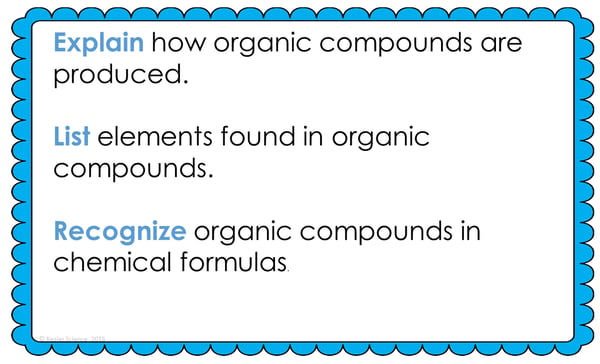
The teacher will help to clear any misconceptions about organic compounds. Some major misconceptions are students often think that the word “organic” means natural and that all compounds found in living organisms are organic.
Estimated Class Time for the Engagement: 20-30 minutes
EXPLORATION
This student-centered station lab is set up so students can begin to explore organic compounds. With nine stations in total, you can introduce organic compounds to your middle school students in a variety of ways! Four of these stations are considered input stations where students will learn new information about organic compounds, and four of the stations are output stations where students will be demonstrating their mastery of the lesson's material. A bonus station offers challenges for your early finishers and independent learners. You can read more about how I set up the station labs here.
Watch It!
At this station, students will be watching a five-minute video explaining organic compounds. Students will then answer some questions relating to the video and record their answers on their lab station sheet. For example: What is an organic compound? Why is carbon so useful in building organic molecules? What are the four main organic polymers?
Read It!
This station will provide students with a one-page reading about macromolecules. In the reading students will discover the four major macromolecules and why they are so important to us. There are four follow-up questions that the students will answer to show reading comprehension of the subject.
Explore It!
Students will be working in pairs to make observations about four models that the teacher created. Each model represents a compound that the students will have to identify as being either organic or inorganic. Students will have to answer a couple of questions about the models and then have to determine which compounds listed on another card are organic or inorganic.
Research It!
The research station will allow students to conduct their own research about macromolecules. Students will choose a topic provided and record information found on the internet about that topic. Some of the information the students will need to supply is what is the function of the topic they researched and give two examples.
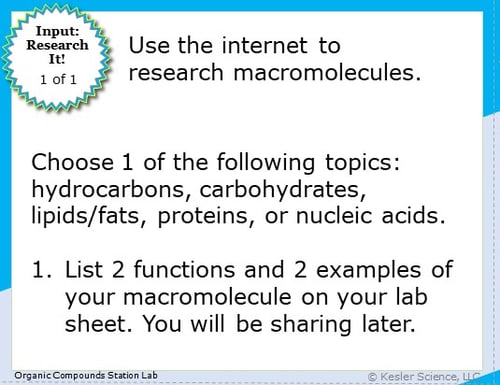
ORGANIZE IT!
The Organize It station allows your students to place cards under columns that describe it as either being information pertaining to organic compounds or inorganic compounds.
Illustrate It!
Your visual students will love this station. Students will create illustrations for both organic and inorganic molecules. Students will be able to use the internet to reference examples.
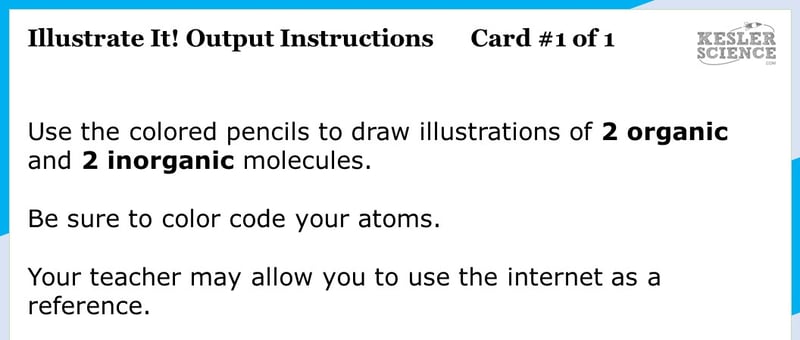
Write It!
Students who can answer open-ended questions about the lab truly understand the concepts that are being taught. At this station the students will be answering three task cards like: Describe the differences between organic and inorganic compounds. Describe whether the chemical formula is organic or inorganic. What is a macromolecule? What are the four major macromolecules?
Assess It!
The Assess It station is where students will go to prove mastery over the concepts they learned in the lab. The questions are setup in a standardized format with multiple choice answers. Some questions will ask students: Which is not a macromolecule? Which statement is not true about macromolecules? Which is not an organic compound? Which statement best describes nucleic acids?
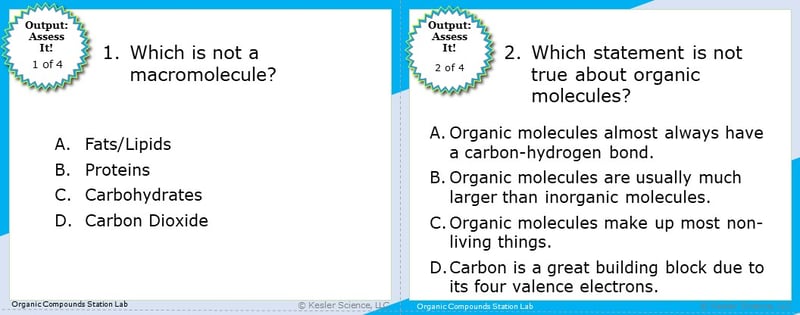
Challenge It! - Bonus Station
Early finishers and advanced students will love the extension activities in this station. Four activity choices offer them ways to expand their learning through mini-games and mini-projects.
Estimated Class Time for the Exploration: One or two 45-minute class periods
EXPLANATION
The explanation activities will become much more engaging for your class once they’ve completed the exploration station lab. During the explanation piece of the lesson, the teacher will be clearing up any misconceptions their students may have about organic compounds with a variety of materials. These materials include on-level and modified versions of the interactive presentation (may be used individually or projected), anchor charts, and paper or digital interactive notebook activities. If you have students that need modified notes, the 5E lessons come equipped to help give every student access to the lesson.
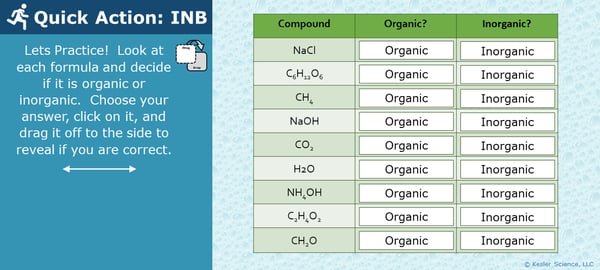

Interactive notebook samples: Above-left is a digital INB activity slide; above-right is an example of the paper INB activities.
The students will also be interacting with their journals using INB templates for organic molecules. Each INB activity is designed to help students compartmentalize information for a greater understanding of the concept. The organic compounds INB templates allow students to focus their notes on learning to identify the four types of macromolecules and the elements that make them up.
Estimated Class Time for the Exploration: Two or three 45-minute class periods
ELABORATION
The elaboration section of the 5E method of instruction gives students choices that allow them to prove they’ve mastered the concepts behind the lesson. When students are given a choice, they’re much more enthusiastic and invested in the project than they are when their teachers choose their projects for them. There are a total of nine choices to demonstrate understanding of organic compounds. A separate set of choices that offer more teacher support are also available for students that need them. Rubrics guide students to doing their best work and assist in grading.

Estimated Class Time for the Elaboration: Two or three 45-minute class periods (can also be used as an at-home project)
EVALUATION
The final piece of the 5E model is to evaluate your students' comprehension. Included in every 5E lesson is a homework assignment, assessment, and modified assessment. Research has shown that homework needs to be meaningful and applicable to real-world activities in order to be effective. When possible, I like to give open-ended assessments to truly gauge the student’s comprehension.
Estimated Class Time for the Elaboration: One 45-minute class period
DOWNLOAD THE FULL LESSON NOW
Download Over $100 in FREE Resources
For Middle School Science
Simply create a login below and gain immediate access to a selection of our Kesler Science product line worth $100 - for FREE. There's a full version of every product type! You'll also join tens of thousands of middle school science teachers who receive timely tips and strategies straight to their inbox.







